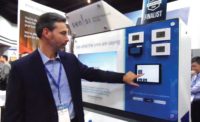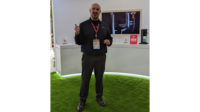Danfoss was recognized four times by this year’s AHR Expo Innovation Awards for products that underscore the company’s commitment to bringing innovative, next-generation solutions to help the industry improve energy efficiency, reduce emissions, and meet climate regulations.
“We are honored to have been recognized again this year in the AHR Expo Innovation Awards program,” said John Galyen, president of Danfoss North America. “In total, Danfoss has been recognized more than 30 times over the past 17 years — a true testament to our investments and dedication to innovation over our entire broad portfolio of technologies. We look forward to working with our industry partners to deploy these solutions in the HVACR market.”
THE PRODUCTS
Winning the cooling category of the Innovation Awards this year is the new Danfoss Interlaced Micro Channel Heat Exchanger, or iMCHE, which integrates multiple circuits into a single coil with shared air heat transfer area, controlling each one independently by a multi-circuit system. The compact, all-aluminum design uses whole air side heat transfer area when operating under partial load conditions to improve system efficiency by more than 20 percent. It also offers 30 percent higher heat transfer efficiency and lower refrigerant charge. With its innovative tube bending structure and passage setup, as well as multi-row compact structure and high-tolerance distributor solution, iMCHE enables design flexibility, modularity, customizability, and extensive flow arrangements that allow chiller and rooftop manufacturers to meet unique challenges.

NEW COIL: Danfoss Interlaced Micro Channel Heat Exchanger, or iMCHE, integrates multiple circuits into a single coil with shared air heat transfer area, controlling each one independently by a multi-circuit system.
The new Danfoss Turbocor® TG490 compressor, designed for air- or water-cooled chillers, won the green building Innovation Award. Per the company, it is the world’s first oil-free, variable-speed, magnetic bearing centrifugal compressor qualified for the use of R-515B. R-515B has an AR5 GWP of 299 and an ASHRAE A1 safety classification for lower toxicity and no flame propagation — enabling compliance with both refrigerant regulations and safety codes. As an extension of the existing Danfoss Turbocor TG series of compressors, TG490 is also qualified to use HFO-1234ze, an environmentally-friendly refrigerant with a GWP less than one, and offers efficiency with no performance degradation.

OIL-FREE COMPRESSOR: Danfoss Turbocor TG490 compressor, designed for air- or water-cooled chillers, is an oil-free, variable-speed, magnetic bearing centrifugal compressor qualified for the use of R-515B.
The new Danfoss CO2 Adaptive Liquid Management (CALM) solution, which won the refrigeration category of the Innovation Awards, combines Danfoss’s liquid ejector and adaptive liquid case controller algorithm to fully utilize the evaporator surface in display cases and cold rooms — providing, without equipment change, up to 10 percent greater energy efficiency on top of energy savings already inherent in CO2 refrigeration. Danfoss’s liquid ejector uses expansion energy from the gas cooler to efficiently remove liquid from the suction side. Its adaptive liquid control case controller algorithm then safely injects more refrigerant into the evaporator, increasing evaporation temperature and raising controlling superheat close to zero. Together in the CALM solution, these components optimize evaporator performance, increase suction pressure, and decrease compressor energy consumption.
The Danfoss CALM solution was further recognized as the Product of the Year during the Innovation Awards ceremony held at the AHR Expo.
In accepting the award, Peter Dee, sales and service director at Danfoss North America, noted, “It’s a huge honor, not just for me for accepting the awards on behalf of Danfoss, but for all the people in the organization that have contributed to this product. This product is unique because it is a combination of all our products coming together with software.”
A finalist in the Innovation Awards’ building automation category was Danfoss VLT® Condition-based Monitoring, which is a new licensed software function for the Danfoss VLT Drives platform that allows users to utilize a drive as a smart sensor to monitor the condition of a motor and application, detect early issues, and find solutions before an impact occurs on the process.
Another interesting feature in the Danfoss booth was a new augmented reality demonstration, which allowed visitors to use a tablet in order to ‘see’ inside the components.
“This is a great feature for customers,” said Lisa Tryson, director of corporate communications at Danfoss. “Our products are typically behind sheet metal, but this allowed booth visitors to see our products operate inside the system.”
CRITICAL ISSUES
Looking ahead, Galyen noted that there are two — separate but related — critical issues set to challenge the HVACR industry: the growing impact of climate regulations and goals, including the demand for smarter, energy-efficient equipment, and the evolving refrigerant landscape.
“Particularly in the U.S., states and cities today are moving to regulate the phasedown of HFCs in the void of federal action,” he said. “The industry has proven it can manage refrigerant transitions (e.g., CFCs and HCFCs), but a patchwork of state and local requirements and timing will present serious challenges. In addition, some of the new low-GWP refrigerants are flammable, and the industry will need time and resources to make a safe transition.”
Another issue for the HVACR industry is the ongoing need to attract more service technicians and provide them with the training they need. Galyen noted that this is the number one issue he hears about when talking with the contractor community.
All of these issues were an integral part of Danfoss’s booth at the AHR Expo, said Tryson.
“We showcased the solutions that can help the industry address critical and ongoing issues like refrigerant regulations and the safe transition to low-GWP refrigerants and the demand for sustained building efficiency and reduced emissions, as well as the emerging megatrend around electrification,” she said. “Danfoss is already helping to meet city and state emissions goals through solutions for rooftop units, chillers, and campuses with multiple buildings.”
See more articles from this issue here!








